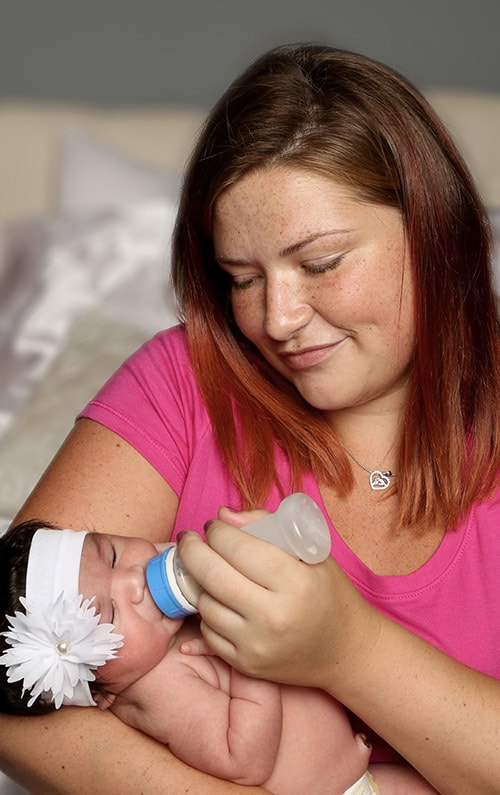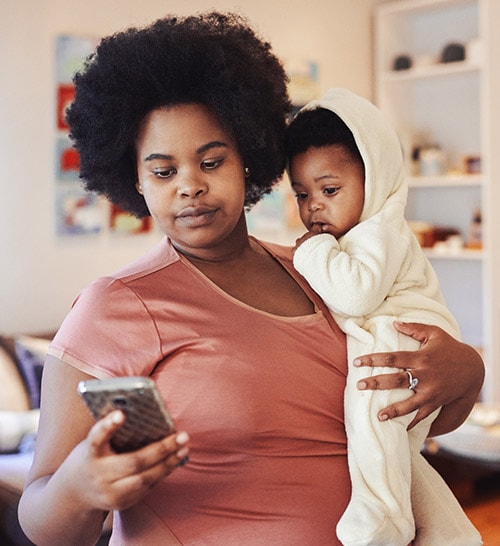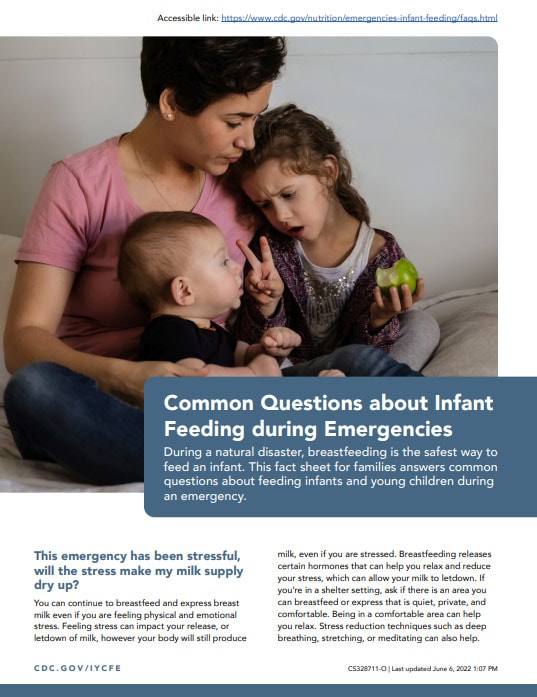Common Questions about Infant Feeding During Emergencies
During a natural disaster, breastfeeding is the safest way to feed an infant. This fact sheet for families answers common questions about feeding infants and young children during an emergency.
This emergency has been stressful, will the stress make my milk supply dry up?
You can continue to breastfeed and express breast milk even if you are feeling physical and emotional stress. Feeling stress can impact your release, or letdown of milk, however your body will still produce milk, even if you are stressed. Breastfeeding releases certain hormones that can help you relax and reduce your stress, which can allow your milk to letdown. If you’re in a shelter setting, ask if there is an area you can breastfeed or express that is quiet, private, and comfortable. Being in a comfortable area can help you relax. Stress reduction techniques such as deep breathing, stretching, or meditating can also help.
I use powdered infant formula at home, why is powdered infant formula not recommended during an emergency?

Using powdered formula requires safe water for mixing, as well as bottles and nipples for feeding that require careful cleaning after every use. If safe water is unavailable or limited during the emergency, you may not be able to safely mix the powdered formula or clean your feeding items after use. If you’re feeding your child formula, ready-to-feed (RTF) infant formula is the safest option to use during an emergency because it does not need to be mixed with water and it comes in individual single-use containers. When powdered infant formula is the only option, extra care must be taken so that it does not become contaminated (unsafe). Extra care includes mixing infant formula with safe water, using a clean measuring scoop, storing the formula can in a cool, dry place with the lid tightly closed, and carefully cleaning all infant feeding items such as bottles, caps, and nipples. Feeding your baby with disposable cups that can be used once and then thrown away can protect your baby from germs that can grow in bottles and nipples. Learn more about how to safely prepare and store powdered infant formula during emergencies.
I brought my baby’s bottles, nipples, and feeding supplies, why is it recommended I use disposable cups instead?
Cleaning reusable infant and toddler feeding items during a natural disaster requires safe water and soap after each use. Safe water may be unavailable, or limited, during an emergency. Also, bottles, nipples, sippy cups, and pacifiers can easily grow germs when they are not cleaned well which can make your baby sick. A heat source may not be available to safely sanitize the bottles either, which can increase the possibility of your baby becoming sick. If bottle nipples, pacifiers, or other hard to clean items come in contact with floodwater, they need to be thrown out. Instead use disposable cups and other feeding items that can be thrown away after one use and don’t need to be cleaned. Ask for help from a lactation support provider if you need to learn how to feed your baby with a cup. Learn more about cup feeding.
I’m pumping my breast milk and I need help, where can I find support?

If you have access to a phone and the ability to call out, call the National Women’s Health and Breastfeeding Helpline Monday through Friday 9am-6pm ET at 1-800-994-9662 to reach a specialist in English or Spanish. You can also contact your doctor or your child’s doctor to receive help or to be connected to another lactation support provider as needed.
If you are in a shelter setting, be sure to tell the shelter staff or emergency relief workers that you’re breastfeeding and/or expressing breast milk. Ask for a quiet, private, and comfortable place where you can breastfeed or express. If you need supplies to feed your child and/or a refrigerator to store your breast milk, ask shelter staff for help. You can also ask the staff if there is someone trained in lactation that you can speak with or a local lactation support provider that you can call. Peer to peer support can also be very helpful; if a trained lactation support provider is not available, ask staff to help you identify another breastfeeding mother that you may be able to speak with.
I feel sick, can I still breastfeed?
If you are feeling sick, or have a fever, call your doctor. If you are in a shelter, notify shelter staff or an emergency relief provider. Be sure to continue to wash your hands with soap and safe water or use a hand sanitizer with at least 60% alcohol to help prevent the spread of germs. You can and should continue breastfeeding while sick with certain illnesses such as the flu, COVID-19, or diarrhea or if you have a breast infection such as mastitis. But it’s important you get medical attention to diagnose your illness. Be sure to tell the medical provider that you are breastfeeding. Although most medicines are okay to take when breastfeeding, certain medications may not be recommended while breastfeeding. Learn more about the safety of common medications while breastfeeding [PDF-84.2KB].
Your body will still produce breast milk even if you are sick and it’s important to rest and keep up your milk supply. If one is available, talk to a lactation support provider about how to keep up your milk supply if you have to stop breastfeeding for a while. If your baby is sick too, breastfeeding can provide comfort and help keep your baby hydrated.
| Human Milk Storage Guidelines | |||
|---|---|---|---|
| Storage Location and Temperatures | |||
| Type of Breast Milk | Countertop 77°F (25°C) or colder (room temperature) |
Refrigerator 40°F (4°C) |
Freezer 0°F (-18°C) or colder |
| Freshly Expressed or Pumped | Up to 4 Hours | Up to 4 Days | Within 6 months is best Up to 12 months is acceptable |
| Thawed, Previously Frozen | 1–2 Hours | Up to 1 Day (24 hours) |
NEVER refreeze human milk after it has been thawed |
| Leftover from a Feeding (baby did not finish the bottle) |
Use within 2 hours after the baby is finished feeding | ||
I had to evacuate (leave) my home and I brought a cooler of breast milk with me. How can I store my milk and how long is it safe to use to feed my baby?
After arriving at your destination, use the milk right away, store it in the refrigerator, or freeze it. If you are in a shelter setting, tell shelter staff or a relief worker that you have a cooler of breast milk with you and ask where you can store it. Ask for supplies to label your milk if you haven’t already. Above are CDC’s milk storage guidelines to help you determine how long to store your milk. Frozen breast milk that has started to thaw but still contains ice crystals can be refrozen. If your breast milk has completely thawed but still feels cold, put it in the refrigerator and use it within the next day or throw it away. See CDC’s Storage and Preparation of Breast Milk [PDF-314KB] handout for more information.
I stopped breastfeeding for a while during the emergency, can I start again?
Relactation is possible. Relactation is when you start breastfeeding again after having stopped for some time (weeks or months). Breastfeeding is a supply and demand process that requires 1) nipple stimulation and 2) the removal of milk from the breast. You may be able to relactate or re-establish your milk production by pumping, hand expressing, and/or nursing directly at the breast often. Breastfeeding whenever your child shows interest and holding your baby skin-to-skin as often as possible can help. Once milk production has started again, continue to nurse or express often to build a milk supply. Relactation depends on many different factors and regular help by a lactation support provider is important. Ask shelter staff or an emergency responder if there is a trained lactation support provider who can help and support you.

